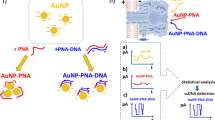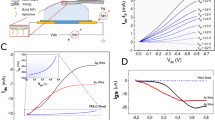Abstract
Recent years have seen the development of a number of reagentless, electrochemical sensors based on the target-induced folding or unfolding of electrode-bound oligonucleotides, with examples reported to date, including sensors for the detection of specific nucleic acids, proteins, small molecules and inorganic ions. These devices, which are often termed electrochemical DNA (E-DNA) and E-AB (electrochemical, aptamer-based) sensors, are comprised of an oligonucleotide probe modified with a redox reporter (in this protocol methylene blue) at one terminus and attached to a gold electrode via a thiol-gold bond at the other. Binding of an analyte to the oligonucleotide probe changes its structure and dynamics, which, in turn, influences the efficiency of electron transfer to the interrogating electrode. This class of sensors perform well even when challenged directly with blood serum, soil and other complex, multicomponent sample matrices. This protocol describes the fabrication of E-DNA and E-AB sensors. The protocol can be completed in 12 h.
This is a preview of subscription content, access via your institution
Access options
Subscribe to this journal
Receive 12 print issues and online access
$259.00 per year
only $21.58 per issue
Buy this article
- Purchase on Springer Link
- Instant access to full article PDF
Prices may be subject to local taxes which are calculated during checkout






Similar content being viewed by others
References
Drummond, T.G., Hill, M.G. & Barton, J.K. Electrochemical DNA sensors. Nat. Biotechnol. 21, 1192–1199 (2003).
Thorp, H.H. Cutting out the middleman: DNA biosensors based on electrochemical oxidation. Trends Biotechnol. 16, 117–121 (1998).
Park, S.J., Taton, T.A. & Mirkin, C.A. Array-based electrical detection of DNA with nanoparticle probes. Science 295, 1503–1506 (2002).
Gibbs, J.M. et al. Polymer-DNA hybrids as electrochemical probes for the detection of DNA. J. Am. Chem. Soc. 127, 1170–1178 (2005).
Wang, J., Liu, G.D. & Zhu, Q.Y. Indium microrod tags for electrochemical detection of DNA hybridization. Anal. Chem. 75, 6218–6222 (2003).
Hwang, S., Kim, E. & Kwak, J. Electrochemical detection of DNA hybridization using biometallization. Anal. Chem. 77, 579–584 (2005).
Fan, C.H., Plaxco, K.W. & Heeger, A.J. Electrochemical interrogation of conformational changes as a reagentless method for the sequence-specific detection of DNA. Proc. Natl. Acad. Sci. USA 100, 9134–9137 (2003).
Immoos, C.E., Lee, S.J. & Grinstaff, M.W. DNA-PEG-DNA triblock macromolecules for reagentless DNA detection. J. Am. Chem. Soc. 126, 10814–10815 (2004).
Immoos, C.E., Lee, S.J. & Grinstaff, M.W. Conformationally gated electrochemical gene detection. ChemBioChem 5, 1100–1103 (2004).
Lubin, A.A., Lai, R.Y., Baker, B.R., Heeger, A.J. & Plaxco, K.W. Sequence-specific, electronic detection of oligonucleotides in blood, soil, and foodstuffs with the reagentless, reusable E-DNA sensor. Anal. Chem. 78, 5671–5677 (2006).
Lai, R.Y., Seferos, D.S., Heeger, A.J., Bazan, G.C. & Plaxco, K.W. Comparison of the signaling and stability of electrochemical DNA sensors fabricated from 6- or 11-carbon self-assembled monolayers. Langmuir 22, 10796–10800 (2006).
Anne, A., Bouchardon, A. & Moiroux, J. 3′-Ferrocene-labeled oligonucleotide chains end-tethered to gold electrode surfaces: novel model systems for exploring flexibility of short DNA using cyclic voltammetry. J. Am. Chem. Soc. 125, 1112–1113 (2003).
Mao, Y.D., Luo, C.X. & Ouyang, Q. Studies of temperature-dependent electronic transduction on DNA hairpin loop sensor. Nucleic Acids Res. 31, e108 (2003).
Ricci, F., Lai, R.Y., Heeger, A.J., Plaxco, K.W. & Sumner, J.J. Effect of molecular crowding on the response of an electrochemical DNA sensor. Langmuir 23, 6827–6834 (2007).
Xiao, Y., Lubin, A.A., Baker, B.R., Plaxco, K.W. & Heeger, A.J. Single-step electronic detection of femtomolar DNA by target-induced strand displacement in an electrode-bound duplex. Proc. Natl. Acad. Sci. USA 103, 16677–17780 (2006).
Xiao, Y., Lubin, A.A., Heeger, A.J. & Plaxco, K.W. Label-free electronic detection of thrombin in blood serum by using an aptamer-based sensor. Angew. Chem. Int. Ed. 44, 5456–5459 (2005).
Radi, A.E., Sanchez, J.L.A., Baldrich, E. & O'Sullivan, C.K. Reagentless, reusable, ultrasensitive electrochemical molecular beacon aptasensor. J. Am. Chem. Soc. 128, 117–124 (2006).
Lai, R.Y., Plaxco, K.W. & Heeger, A.J. Aptamer-based electrochemical detection of picomolar platelet-derived growth factor directly in blood serum. Anal. Chem. 79, 229–233 (2006).
Baker, B.R. et al. An electronic, aptamer-based small-molecule sensor for the rapid, label-free detection of cocaine in adulterated samples and biological fluids. J. Am. Chem. Soc. 128, 3138–3139 (2006).
Zuo, X. et al. A target-responsive electrochemical aptamer switch (TREAS) for reagentless detection of nanomolar ATP. J. Am. Chem. Soc. 129, 1042–1043 (2007).
Xiao, Y., Rowe, A.A. & Plaxco, K.W. Electrochemical detection of parts-per-billion lead via an electrode-bound DNAzyme assembly. J. Am. Chem. Soc. 129, 262–263 (2006).
Ricci, F., Lai, R.Y. & Plaxco, K.W. Linear, redox modified DNA probes as electrochemical DNA sensors. Chem. Commun. 36, 3768–3770 (2007).
Hamula, C.L.A., Guthrie, J.W., Zhang, H.Q., Li, X.F. & Le, X.C. Selection and analytical applications of aptamers. Trac-Trends Anal. Chem. 25, 681–691 (2006).
Lai, R.Y., Lee, S.-H., Soh, H.T., Plaxco, K.W. & Heeger, A.J. Differential labeling of closely-spaced biosensor electrodes via oxidative desorption. Langmuir 22, 1932–1936 (2006).
Carvalhal, R.T., Freire, R.S. & Kubota, L.T. Polycrystalline gold electrodes: a comparative study of pretreatment procedures used for cleaning and thiol self-assembly monolayer formation. Electroanalysis 17, 1251–1259 (2005).
Willner, I. & Riklin, A. Electrical communication between electrodes and NAD(P)(+)-dependent enzymes using pyrroloquinolinequinone-enzyme electrodes in a self-assembled monolayer configuration—design of a new glass of amperometric biosensors. Anal. Chem. 66, 1535–1539 (1994).
O'Connor, S.D., Olsen, G.T. & Creager, S.E. A Nernstian electron source model for the ac voltammetric response of a reversible surface redox reaction using large-amplitude ac voltages. J. Electroanal. Chem. 466, 197–202 (1999).
Lai, R.Y. et al. Rapid, sequence-specific detection of unpurified PCR amplicons via a reusable, electrochemical sensor. Proc. Natl. Acad. Sci. USA 103, 4017–4021 (2006).
Acknowledgements
This work was supported by Lawrence Livermore National Laboratory (URP-06-019), by the Institute for Collaborative Biotechnologies through grant DAAD19-03-D-0004 from the US Army Research Office. We also thank Arica Lubin and Francesco Ricci for critically reading this manuscript.
Author information
Authors and Affiliations
Corresponding author
Rights and permissions
About this article
Cite this article
Xiao, Y., Lai, R. & Plaxco, K. Preparation of electrode-immobilized, redox-modified oligonucleotides for electrochemical DNA and aptamer-based sensing. Nat Protoc 2, 2875–2880 (2007). https://doi.org/10.1038/nprot.2007.413
Published:
Issue Date:
DOI: https://doi.org/10.1038/nprot.2007.413
This article is cited by
-
Field effect transistor based wearable biosensors for healthcare monitoring
Journal of Nanobiotechnology (2023)
-
Organic electrochemical transistors as on-site signal amplifiers for electrochemical aptamer-based sensing
Nature Communications (2023)
-
Design of a printed electrochemical strip towards miRNA-21 detection in urine samples: optimization of the experimental procedures for real sample application
Analytical and Bioanalytical Chemistry (2023)
-
Wearable chemical sensors for biomarker discovery in the omics era
Nature Reviews Chemistry (2022)
-
Computational design of single-stranded DNA hairpin aptamers immobilized on a biosensor substrate
Scientific Reports (2021)
Comments
By submitting a comment you agree to abide by our Terms and Community Guidelines. If you find something abusive or that does not comply with our terms or guidelines please flag it as inappropriate.



